Layman D. Biology Demystified: A Self-Teaching Guide
Подождите немного. Документ загружается.


The urocyst empties into the urethra (you-REETH-rah), the tube that
helps a person literally ‘‘make water’’ (urethr) – that is, urinate (YUR-ih-
nayt). Surrounding the upper neck of the urethra is the urinary sphincter.
Much like the external anal sphincter in the digestive pathway (Chapter 19),
the urinary sphincter is a ring of voluntary striated muscle. This means, of
course, that the contraction and relaxation of this sphincter is under our
voluntary control. Thus, after we have been adequately ‘‘potty-trained’’ dur-
ing early childhood, we can voluntarily relax the urinary sphincter whenever
the place and time are right for urination!
Finally, urine exits out of the body through the urinary orifice (OR-ih-fis),
a tiny, ‘‘mouth’’ (or)-like opening.
The Process of (‘‘Making Water’’) or Excreting
Urine
We have, from time to time, been using some very basic descriptive equations
in this book. Let us do so, again. We can state the urinary excretion equation,
for example:
CHAPTER 20 Urine and Sex in Animals 347
[13:27 13/6/03 N:/4058 LAYMAN.751/4058-Alltext.3d] Ref: 4058 Layman: Biology Demystified All-text Page: 347 1-388
Fig. 20.2 The urinary pathway.

E ¼ F R þ S
(This equation is put into visual form within Figure 20.3.)
In this equation, E stands for ‘‘excretion,’’ F for amount filtered, R for the
amount of tubular reabsorption, and S for tubular secretion. The urinary
filtrate (FIL-trayt), or filtration product, comes from the pushing force of
the blood pressure against the walls of the renal capillaries in the glomeruli
(glah-MEHR-you-lie). This quantity of filtrate is huge, averaging about 180
liters of fluid per day, in an average adult! [Study suggestion: Assume that an
adult has a blood volume of about 6 liters. Then, on average, how many
times is this person’s entire blood volume filtered out of his glomeruli, each
day?]
While it may seem wasteful, the huge volume of urinary filtrate (F) acts as
the starting point for the urine. Because there is so much of this filtrate, the
body can adjust many factors to influence how much urine is actually
excreted, under particular current conditions.
After urinary filtration, one of the chief processes is tubular reabsorption
(R). Reabsorption is the movement of material out of the filtrate, across the
walls of the urinary tubules, and back into the bloodstream. Consider, for
example, the tubular reabsorption of glucose. Under normal conditions,
almost 100% of the glucose that is filtered into the urinary tubules is even-
tually reabsorbed back into the bloodstream. As a result, the urine excreted
from the body is nearly free of glucose. Several hormones also control the
amount of sodium (Na
þ
ions) and water (H
2
O) molecules that are reab-
sorbed back into the bloodstream. Because the amount of sodium (salt)
and water reabsorbed can vary greatly, the kidneys play a critical role in
regulating the salt–water balance of the human bloodstream.
Under typical conditions, about 99%, or 179 liters, of the urinary filtrate
(mostly water) is reabsorbed. [Study suggestion: If a person becomes extre-
mely dehydrated, as after excessive sweating, then what do you predict will
happen to the amount of H
2
O reabsorbed? Will the percent (%) reabsorbed
increase above typical conditions, or decrease below it? Why?]
Another process, tubular secretion (S), involves the active (ATP-requiring)
addition of small quantities of particular chemicals from the bloodstream,
into the urinary tubules. Molecules of penicillin (pen-ih-SILL-in) and many
other antibiotics (an-tih-buy-AH-ticks), for instance, are just too large to be
filtered across the walls of the glomeruli. Hence, the epithelial cells lining the
blood vessels actively pump the penicillin into the urinary tubules. Therefore,
penicillin is excreted (E) out of the body, via the urine. Although only a few
milliliters (ml) of fluid are generally secreted each day, they still have an
important influence.
[13:27 13/6/03 N:/4058 LAYMAN.751/4058-Alltext.3d] Ref: 4058 Layman: Biology Demystified All-text Page: 348 1-388
PART 4 Anatomy and Physiology of Animals
348
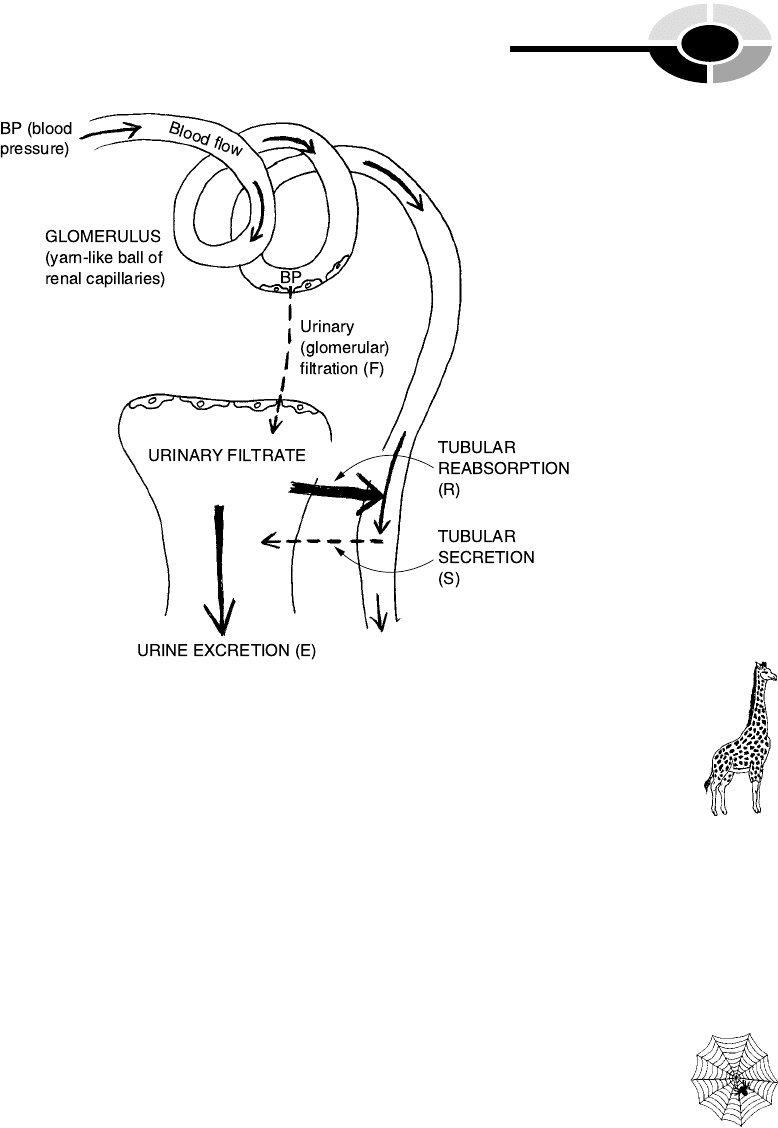
Summarizing our previous urinary excretion equation and plugging in
some numbers, we get:
E ¼ F R þ S
1 L/day of urine excreted ¼ 180 L=day 179 L=day þ (a few ml/day)
Reproduction in Animals: Sexual or Asexual?
Earlier chapters have talked about sexual reproduction occurring in animal
organisms and in non-animal organisms such as in the World of Plants
(Chapter 9). Even in reproducing pine trees, there are sperm cells from the
male (pollen) cones that fertilize egg cells (ova) from the female (seed) cones,
thereby resulting in a zygote. The lowly fungi (Chapter 8) were likewise
shown to engage in sexual reproduction – the fusion of a male and female
gamete (sex cell) to create a zygote. And this zygote in turn develops into an
embryo, within many different types of organisms.
CHAPTER 20 Urine and Sex in Animals 349
[13:27 13/6/03 N:/4058 LAYMAN.751/4058-Alltext.3d] Ref: 4058 Layman: Biology Demystified All-text Page: 349 1-388
Fig. 20.3 Processes involved in excretion of urine.
3, Order
2, Web
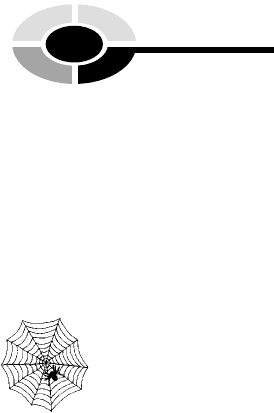
ASEXUAL REPRODUCTION IN ANIMALS
But we also need to remember that asexual reproduction is likewise common!
In this reproductive strategy, there are no gametes or sex cells involved.
Asexual reproduction, you may remember, is important in the spreading of
the black bread mold, Rhizopus. (Review Figure 8.4, if desired.)
Certain animals (living organisms that are neither plants nor fungi) also
use asexual means to reproduce themselves. Not surprisingly, the animals
engaging in asexual reproduction are generally among the most primitive.
Consider, for example, the invertebrates (Chapter 10). Certain types of star-
fish reproduce asexually by means of fragmentation (breaking of their body
into fragments), followed by regeneration (the re-growing of lost body parts).
When such a starfish has one of its arms fragmented (broken off), an exten-
sive series of mitoses (my-TOH-seez) or cell divisions occur within the broken
arm fragment. One such broken arm can thus asexually reproduce (via mito-
sis) a whole new starfish!
Sea anemones (also mentioned in Chapter 10) can asexually reproduce by
means of fission (FIH-shun) – ‘‘the process of ’’ (-ion) ‘‘splitting or cleaving’’
(fiss). In this case, one approximately round sea anemone stretches into two
identical individuals, creating a type of dumbbell-shaped pattern. The two
duplicate individual sea anemones then split or cleave apart.
Finally, some invertebrates such as tunicates asexually reproduce by bud-
ding. A new individual simply grows as a small bud off the body of a parent.
When the growing bud becomes large enough, it separates from the parent
body.
Basically, all of the above examples of asexual reproduction have two main
features in common:
1. The major mechanism for reproduction is simply an extensive series of
mitoses (cell divisions involving no reduction in the number of
chromosomes present).
2. A group of clones (KLOHNS) – identical copies of a single parent
organism – is created. Like a branch or ‘‘twig’’ (clon) growing from the
trunk of the same tree, a clone has an exact copy of the genes and
chromosomes of its parent.
EXTERNAL FERTILIZATION: SEXUAL REPRODUCTION IN
LOWER VERTEBRATES
In animals engaging in sexual reproduction, the mature ovum of the female is
fertilized by a sperm cell from the male. In certain types of lower (more
[13:27 13/6/03 N:/4058 LAYMAN.751/4058-Alltext.3d] Ref: 4058 Layman: Biology Demystified All-text Page: 350 1-388
PART 4 Anatomy and Physiology of Animals
350
3, Web

primitive) vertebrates, such as fish and amphibians, there is external fertiliza-
tion of the ovum ‘‘outside of ’’ the body of the female.
Consider two mating frogs. The larger female frog is mounted by a smaller
male, who clasps her body with his forelimbs. This helps stimulate the female
to release a mass of over 100 eggs into the pond water! Nearly simulta-
neously, the male frog releases a jet of sperm cells, which fertilize many of
the ova externally, right in the surrounding water. After a time of develop-
ment, the fertilized ova develop into swimming tadpoles.
INTERNAL FERTILIZATION: SEXUAL REPRODUCTION IN
HIGHER VERTEBRATES
When one examines the mating of higher vertebrates such as mammals,
sexual reproduction generally occurs via internal reproduction. In this type
of reprodution, the ovum is fertilized by mature sperm cells that have tra-
veled ‘‘within’’ (intern) the female body.
Reproductive System of the Male Mammal
In order to fully understand internal fertilization, we must first study the
reproductive system of the male and female mammal (in particular, of
human beings).
Figure 20.4 reveals the basic anatomy of the reproductive system in the
human male. A scrotum (SKROH-tum) or ‘‘leathery bag of skin’’ (scrot)
suspends the two testes (TES-teez) outside of the abdominal cavity. Each
testis (TES-tis) is a rather oval, whitish, ‘‘eggshell’’ (test)-like structure that
contains the seminiferous (sem-ih-NIF-er-us) tubules. The seminiferous
tubules are a collection of tiny, highly coiled tubes that carry out the process
of spermatogenesis (sper-mat-uh-JEN-eh-sis) – the ‘‘production of ’’ (-genesis)
‘‘sperm’’ (spermat) cells.
From the time of puberty (age 12–13 years) onward, mature sperm cells
are continually produced by a germinal (JER-muh-nal) epithelium, which is
located in the thick walls of the seminiferous tubules. This germinal epithe-
lium undergoes a constant process of ‘‘sprouting’’ (germin) new sperm cells
by mitosis, followed by meiosis.
You may recall (Chapter 9) that meiosis is literally ‘‘a conditioning of
lessening.’’ This implies that division of a parent cell by meiosis lessens or
reduces the number of chromosomes in each resulting daughter cell by one-
CHAPTER 20 Urine and Sex in Animals 351
[13:27 13/6/03 N:/4058 LAYMAN.751/4058-Alltext.3d] Ref: 4058 Layman: Biology Demystified All-text Page: 351 1-388
4, Web
5, Web
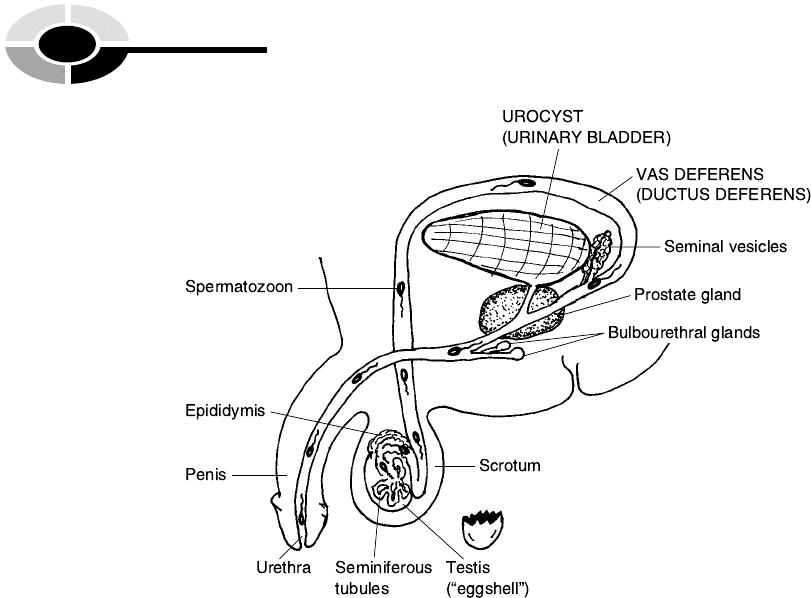
half. In the human male, each primitive sperm cell contains 46 chromosomes
within its nucleus. But after meiosis, the developing sperm cell has this
reduced by half, to a total of just 23 chromosomes. Eventually, a mature
spermatozoon (sper-mat-uh-ZOH-un) or ‘‘seed’’ (sperm) ‘‘animal’’ (-zoon)
with only 23 chromosomes results.
Thousands of mature spermatozoa (sper-mah-tah-ZOH-ah) or ‘‘seed ani-
mals’’ leave the germinal epithelium of the seminiferous tubules, and are
temporarily stored within the epididymis (eh-pih-DID-ih-mus). The epididy-
mis is a curved, comma-shaped pouch that literally lies ‘‘upon’’ (epi-) each
testis or ‘‘eggshell’’ (didym). The thousands of spermatozoa are ejected from
the epididymis during each ejaculation (ih-JACK-yuh-lay-shun). Ejaculation
is literally the ‘‘throwing out’’ (ejacul) of semen (SEE-mun) and spermatozoa
from the urinary orifice at the tip of the penis.
ACCESSORY REPRODUCTIVE ORGANS IN THE MALE
The semen is a thick, milky, sugar-rich, very basic fluid that suspends the
spermatozoa and gives them nutrition. When the male has an orgasm (OR-
gaz-um), or is literally ‘‘swollen and excited,’’ he ejaculates spermatozoa
suspended in a fluid of semen. The stored spermatozoa are actively sucked
[13:27 13/6/03 N:/4058 LAYMAN.751/4058-Alltext.3d] Ref: 4058 Layman: Biology Demystified All-text Page: 352 1-388
PART 4 Anatomy and Physiology of Animals
352
Fig. 20.4 The male reproductive pathway.
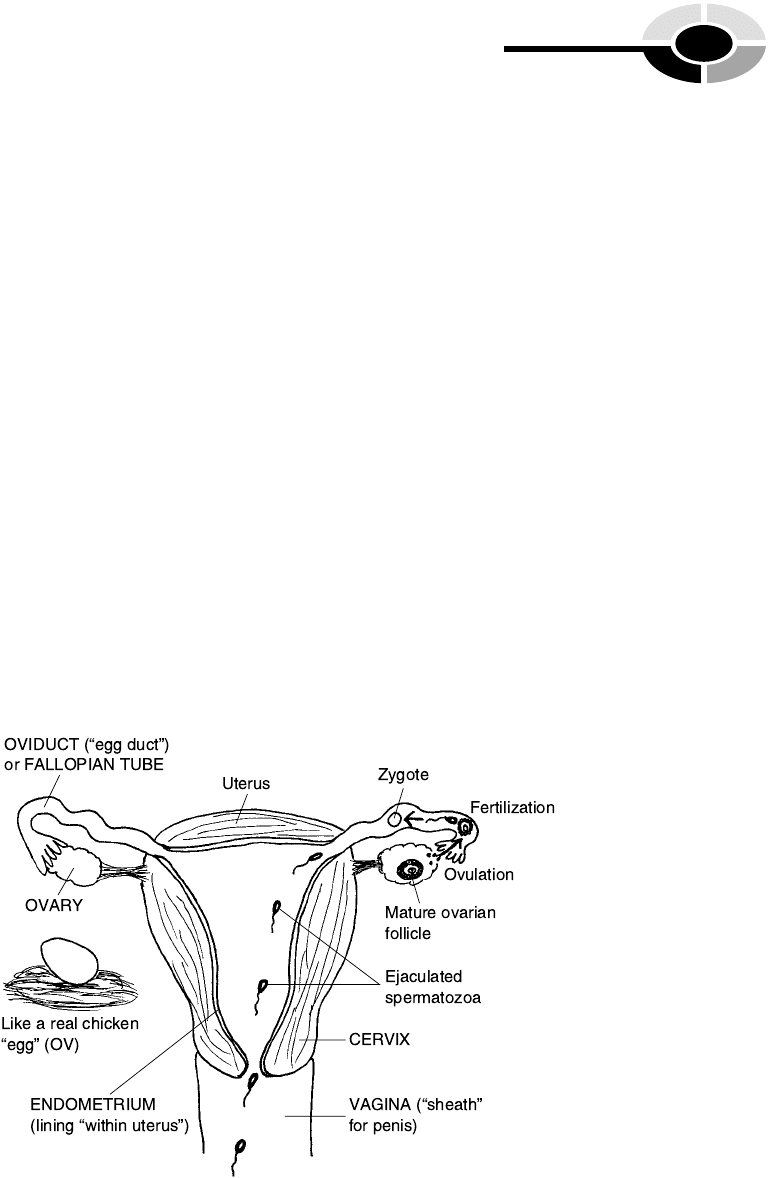
out of the epididymis by strong peristalsis (ring-like muscular contractions)
of the walls of the vas (vas) deferens (DEF-er-enz).
The vas deferens, or ‘‘carrying away’’ (deferens) ‘‘vessel’’ (vas), is not
actually a blood vessel at all. More appropriately, it is alternately called
the ductus (DUCK-tus) deferens or ‘‘carrying away duct.’’ During male
orgasm, the walls of the vas deferens (ductus deferens) powerfully and rhyth-
mically constrict or narrow. This negative pressure (suction) event draws the
stored spermatozoa out of the epididymis, carrying them over the top of the
urinary bladder and out into the urethra.
Semen is added to the spermatozoa from a number of accessory male
reproductive organs. These accessory male reproductive organs include the
two seminal (SEM-ih-nal) vesicles, the two bulbourethral (BUL-boh-you-
REE-thral) glands, and the single prostate (PRAH-state) gland.
Reproductive System of the Female Mammal
In order to achieve internal fertilization, the penis of the male must be
inserted into the vagina (vah-JEYE-nah), a tapered ‘‘sheath’’ (vagin) that
also serves as the birth canal. The vagina leads into the uterus or womb
through a tiny hole in its neck-like cervix (SIR-viks) (see Figure 20.5).
CHAPTER 20 Urine and Sex in Animals 353
[13:27 13/6/03 N:/4058 LAYMAN.751/4058-Alltext.3d] Ref: 4058 Layman: Biology Demystified All-text Page: 353 1-388
Fig. 20.5 The female reproductive pathway and internal fertilization.

Attached to the top of the uterus are the right and left oviducts (OH-vih-
ducts) or ‘‘egg ducts.’’ The oviducts are alternately called the Fallopian (fah-
LOH-pea-un) tubes in honor of their discoverer, the Italian anatomist,
Gabriello Fallopio (fah-LOH-pea-oh). The oviducts (fallopian tubes) are a
pair of slender egg ducts that carry ova towards the uterus.
The ova are released from the ovaries (OH-var-eez). There is both a right
ovary and a left ovary, each named for their oval, whitish appearance, much
like a chicken ‘‘egg’’ (ovari).
INTERNAL FERTILIZATION AND THE FEMALE
REPRODUCTIVE PATHWAY
The key to internal fertilization, of course, is both ejaculation by the male and
ovulation by the female. (You may want to review appropriate parts of
Chapter 15, the glands, at this point.) Previously, we learned that increased
secretion of luteinizing hormone was the usual trigger for ovulation. Basically,
the LH (luteinizing hormone) dissolves and weakens the outer surface of the
ovary, allowing a mature ovarian follicle to rupture and release an ovum.
The ovum is usually swept up into a nearby oviduct (Fallopian tube).
Fertilization usually occurs in the first (outer) 1/3 of the oviduct. Fusion of
sperm and ovum creates a zygote. As the zygote moves through the oviduct
and towards the uterus, it undergoes a series of mitoses (my-TOH-seez).
Embryo Development Leading to Birth
The single-celled zygote becomes a solid mass of cells called a morula (mor-
OO-luh), whose name comes from the Latin for ‘‘little mulberry.’’ The mor-
ula passes out of the oviduct and enters the body (main hollow cavity) of the
uterus. Here it becomes a blastula (BLAS-chew-lah), alternately called a
blastocyst (BLAS-toh-sist). The blastula (blastocyst) is a ‘‘little sprouter’’
(blastul) or ‘‘hollow sprouting bladder’’ (blastocyst) that embeds itself within
the endometrium (en-doh-ME-tree-um), the ‘‘inner’’ (endo-) epithelial lining
of the ‘‘uterus’’ (metr).
After the blastula (blastocyst) implants itself into the uterine (YOU-ter-in)
wall, it starts a process of cellular differentiation (the cells becoming different
from each other and specialized). This leads to a gastrula (GAS-true-lah) or
hollow ‘‘little stomach’’ (gastrul). As Figure 20.6 clearly displays, the gastrula
gives rise to the three primary germ layers of the human embryo.
[13:27 13/6/03 N:/4058 LAYMAN.751/4058-Alltext.3d] Ref: 4058 Layman: Biology Demystified All-text Page: 354 1-388
PART 4 Anatomy and Physiology of Animals
354
4, Order
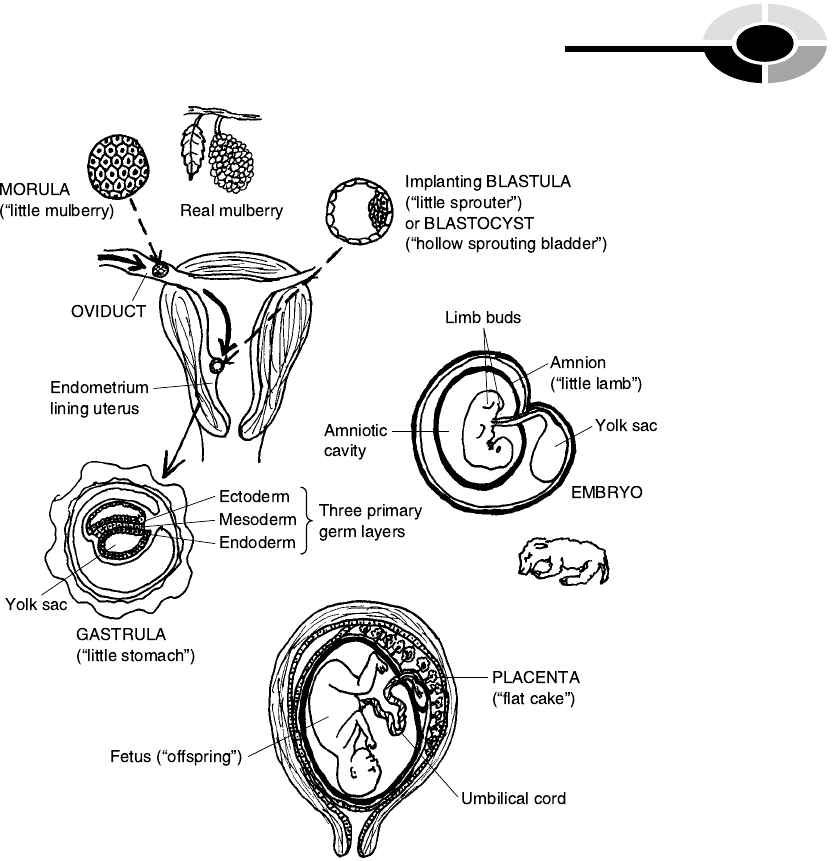
The gastrula does, indeed, have some of the same characteristics as a
miniature version of the real stomach! Besides having a hollow interior, the
gastrula (like the real stomach), has multiple layers of cells within its walls.
These cell layers are technically called derms – various layers of ‘‘skin.’’
The endoderm (EN-doh-derm), or ‘‘inner skin,’’ for instance, eventually
creates much of the inner lining of the main body cavities in the mature
adult. The mesoderm (ME-so-derm) – ‘‘middle skin’’ – differentiates to
become bone and muscle tissue. And the ectoderm (EK-toh-derm) specializes
to ultimately become much of the skin and nervous system. It is the skin and
nervous system (Chapter 14), after all, that lies at or near the body surface,
CHAPTER 20 Urine and Sex in Animals 355
[13:27 13/6/03 N:/4058 LAYMAN.751/4058-Alltext.3d] Ref: 4058 Layman: Biology Demystified All-text Page: 355 1-388
Fig. 20.6 From embryo to fetus.

[13:27 13/6/03 N:/4058 LAYMAN.751/4058-Alltext.3d] Ref: 4058 Layman: Biology Demystified All-text Page: 356 1-388
reacts to environmental stimuli, and communicates extensively about such
stimuli.
To summarize the above information, we have:
THREE PRIMARY GERM LAYERS OF THE EMBRYO ¼
Endoderm (‘‘Inner skin’’) þ Mesoderm (‘‘Middle skin’’) þ
Ectoderm (‘‘Outer skin’’)
FROM EMBRYO TO FETUS
The embryo, in general, represents a ‘‘sweller.’’ In humans, the embryo repre-
sents all of the stages of body development that occur during the first 3
months of development. This starts with the zygote stage and includes the
morula, blastula (blastocyst), and gastrula.
The embryo body keeps ‘‘swelling’’ by extensive mitoses, adding thousands
and thousands of new tissue cells. The embryo body becomes surrounded by
an amnion (AM-knee-un). The amnion is a protective membrane forming a
sac around the embryo of ‘‘little lambs’’ (amnions), human beings, and other
mammals. An amnion also protects the embryos of other types of higher
vertebrates such as birds and reptiles. The amnion also encloses a quantity
of amniotic (am-knee-AH-tik) fluid. This fluid creates a watery cushion and
shock absorber for the embryo, as well as keeping the body wet and moist.
A yolk sac provides nourishment for the early embryo. Limb buds develop
and mark the locations of the future body limbs. An umbilical (um-BILL-ih-
kal) cord stretches from the ‘‘central pit’’ (umbilic) area present in the mid-
section of the embryo, out to the placenta (plah-SEN-tah). The placenta is a
‘‘flat cake’’ (placent)-like organ that supplies nourishment to the later embryo
and fetus as the yolk sac progressively shrinks in size.
The fetus is the stage of the ‘‘offspring’’ from the third month after ferti-
lization, up to the time of birth. The ‘‘newborn’’ child is literally a neonate
(KNEE-oh-nayt).
Sexual Dysfunctions and Reproductive Failure
A sexual dysfunction (dis-FUNK-shun) is a type of ‘‘bad, painful, or difficult’’
(dys-) failure of reproduction. There are many specific types of sexual dys-
function – some involving the male reproductive pathway, some involving the
female reproductive pathway – so that successful production of a zygote is
PART 4 Anatomy and Physiology of Animals
356
5, Order
1, B-Web
